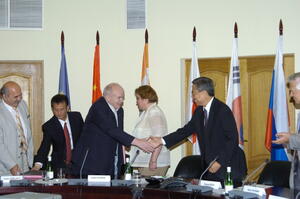Procurement Arrangements signed for upper ports and divertor dome
On Tuesday, 9 June 2009, the Procurement Arrangements for the upper ports of the ITER vacuum vessel and the divertor dome were signed at the Kurchatov Institute in Moscow, Russia. Director-General Kaname Ikeda signed the contract on behalf of the ITER Organization and Academician Evgeny Velikhov, President of the Kurchatov Institute and Vice-Chair of the ITER Council, on behalf of the Russian Federation.
In total, the ITER vacuum vessel is equipped with 44 ports installed at three levels—upper, equatorial and lower—providing access to the vacuum vessel. The 18 upper ports each measure 2.5 x 3.5 metres on the outer side and 1.5 x 1.5 metres on the inner side of the six-metre-long "corridor" and have several service functions: hosting of the diagnostic port plugs for diagnostics and the launchers for ITER's radiofrequency heating system. They will also host the extensions of the in-vessel cooling pipes and coils for mitigation of the plasma instabilities, for which they are equipped with special "chimneys." As the ports are an intrinsic part of the first confinement and safety boundary provided by the vacuum vessel system, their manufacturing requires strict quality assurance and close adherence to the nuclear code and regulations.
The Procurement Arrangement for the equatorial and lower ports was signed with Korea last November.
The second Procurement Arrangement that was signed in Moscow this week comprises the manufacturing of the divertor dome. One of the key components of the ITER machine, the Divertor is situated along the bottom of the vacuum vessel. It extracts heat and helium ash—the products of the fusion reaction—and other impurities from the plasma, in effect acting like a giant exhaust pipe.
The divertor structure comprises a cassette body and three plasma-facing components, namely the inner vertical target, the outer vertical target and the dome. The inner and outer vertical targets are the components that directly face the hot plasma and will have to remove the heat load via conduction and convection. The dome baffles the neutral particles stemming from the fusion reaction and protects the divertor's cassette body and the diagnostic instruments from direct interaction with the plasma.
The dome itself consists of a steel supporting structure onto which the plasma-facing units are mounted. All three plasma-facing units, the inner particle reflector plate, the umbrella and the outer particle reflector plate are coated with tungsten-carbon fibre composite, a high-refractory material. In order to remove the heat, the dome is actively cooled by pressurized water.




